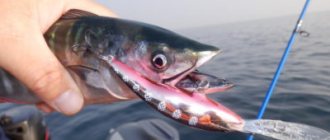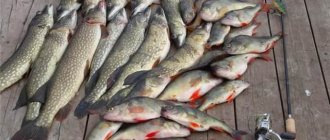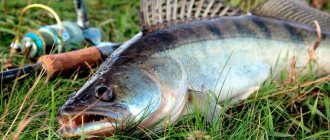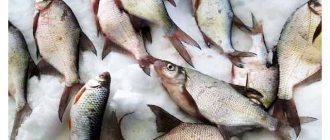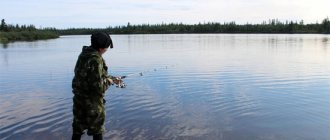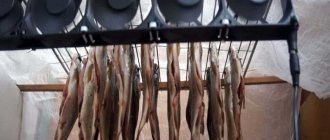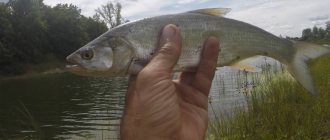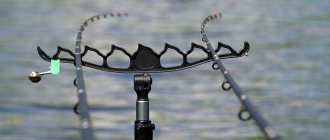Fishing is one of the most popular hobbies of men around the world, a tribute to primitive traditions and a great way to unwind. It doesn’t matter whether the man is fed by this fishery, or the man simply goes to the shore to drink - he certainly takes a fishing rod and other related accessories with him. For avid fishermen, neither the weather nor the seasons are an obstacle, but for everyone else, the best time to test their skills is, of course, summer. How to start fishing, what to buy, what time to head out to the water, and how to avoid getting hooked on your own scrotum out of habit - all this is in our guide for novice fishermen.
There are many techniques and tactics in fishing that require skills and knowledge acquired with practice. Here we focus on the simplest things that even a child who wants to pick up a rod and catch something for the first time can master.
InventoryOption 1. Fishing rod
The simplest tool for coastal fishing is a traditional fishing rod without any extra frills. It’s not expensive, you don’t mind breaking it, and its interface is intuitive: cast it and wait for the float to twitch. In the case of a fishing rod, the only thing you need to learn is how to place bait (a worm or maggot) on the hook. Fishing with bread or meat sausage is a problem-free activity; It is much more difficult at first to get comfortable with worms, which need to be torn into several parts by hand and then dragged through the point with the whole body, overcoming the hysterical resistance of the victim.
The optimal fishing rod length for starting a fishing career is 4 - 4.5 meters. A six-meter fishing rod is too difficult for a beginner to handle, especially when removing fish from the water - this must be done quickly and sharply, and you still need to get used to such a rocker.
The fishing line must be selected according to the load capacity parameter . Optimal - up to 4 kg. Considering how many knots you will wind around the rod, hook and float during your debut fishing, it is best to take a skein with a reserve of 12 meters.
The float can be selected by color . Its only task is to notify the fisherman about the bite, and there are no tricky hidden parameters here. In Soviet times, even avid fishermen sometimes used a wine cork as a float.
It is much more important to choose the right sinkers . These are metal weights that are suspended on a fishing line between the hook and the float; they are needed so that the latter stands normally in the water, and does not float sideways on the surface. The selection of sinkers is carried out in accordance with the weight indicated on the float.
There are different hooks, and each type implies either a specific trophy, or a specific fishing and hooking technique. For a novice fisherman, a simple small hook without unnecessary gags and infernal teeth is enough.
You will also need a simple reel without bells and whistles - it is needed so that you can not wind the fishing line on your hand, but can fish comfortably.
One of the main principles of fishing is this: if you are not going to eat the fish you catch, let it go . At first, this will have to be done quite often, since novice fishermen most often catch gobies and other small things that are only suitable for feeding cats. But it happens that the fish clings to the hook not with its lip or cheek, but swallows it completely, and the tool needs to be retrieved somehow. It will not be difficult for a professional to tear the unlucky prey with his hands; a beginner will need a special device to remove the hook (and save the life of the victim) - an extractor . It can be replaced with a surgical clamp, which will allow you to penetrate deep into the fish and remove the hook from there without difficulty and bloodshed.
To avoid injury and not to catch your neighbor with your hook, you need to throw the fishing line into the water carefully , without sweeping gestures and in no case like in the cartoon “Well, wait a minute!” It is enough to lightly swing the rod from the bottom up and release the hook towards the water, and the natural balance of the entire structure will pull the sinkers in the desired direction.
Option 2. Spinning
The spinning reel is similar to the BFG-9000.
Fishing with a spinning rod looks more technological and therefore more attractive to amateurs, but chance plays a huge role here. I threw it in and pulled it out, threw it in and pulled it out, and so on until I was blue in the face. On the way to shore, the hook may or may not catch someone, and the whole process can be quite tedious.
The prices for spinning rods are scattered so much that it is realistic to exchange some devices for an average car, but to get started, a design a little more expensive than a couple of thousand rubles will be enough , which at least will not fall apart in your hands from careless handling.
The optimal rod length for a debut is about two meters. One of the main elements of a spinning rod is an inertia-free reel, which can accommodate 70 meters of fishing line. The fishing line itself is needed with a carrying capacity of up to 6-7 kilograms.
An important feature of the spinning rod is that its owner catches fish not with live bait, but with a silicone imitation of live bait , which glitters, twitches and plays in every possible way when reeling in the reel and approaching the shore. In this regard, you can catch something that is not at all what you came for - for example, instead of a perch, you can run into a larger predatory fish with sharp teeth that will cut the line and deprive you of at least the bait. To protect yourself from an unplanned loss of money, you need to buy an additional so-called leash - a steel or tungsten cord 10-12 centimeters long, which is attached to the fishing line at one end, and ends with the bait and hook at the other.
As a result of all procedures, the design should be as follows: fishing line -> leash -> jig head -> silicone fish.
Silicone bait mounted on a jig head.
In general terms, a jig head is both a sinker, a hook, and a frame on which the artificial bait is mounted. There are different types of fish, but they are all designed to irritate the fish and attract its attention.
The size of the fish doesn't matter . A pike weighing 12 kilograms can easily bite on a small silicone bait the size of a finger.
When choosing a jig head, it is important to look at the casting capacity of the purchased spinning rod and follow it .
If you overdo it a little, the rod tip will break.
First fishing trip. Where to begin?
What is fishing? For each person it is individual in its own way, but what probably unites everyone is a great time, and if the catch is decent, then this time will be simply unforgettable.
Fishing today is not only a hobby and recreation; fishing today is a powerful industry that promotes a huge number of different products to the market, which often confuses beginners due to lack of knowledge in choosing and the ability to use these products.
Where should a novice fisherman start? In order not to make your head spin from an excess of information, you need to start with the simplest things, collect the minimum necessary information. In fact, the key to the success of any fishing comes down to the following, you just need to choose:
- where to fish?
- what to catch?
- what to catch?
- what to catch?
First you need to select a body of water; when going to a specific body of water, you need to collect as much information as possible about this place. You need to find out how to get to the chosen place easier and faster, what kind of fish is found in a given body of water, what the bottom topography is like, what local fishermen use to fish. The more information you have about the selected body of water, the easier it will be to make a choice of what exactly you need to take with you.
Next, you need to decide which type of fish to give preference to. All fish, despite the many species and subspecies, can be divided into two groups: predators and peaceful ones, the fishing of which differs greatly from each other, both in equipment and in the fishing technique itself. Understanding what exactly the fisherman is going to catch, you can approach the next question. What to catch? All technical devices for fishing are called fishing gear. For beginner anglers, you need to start with traditional fishing methods using fishing rods.
Despite the huge variety of rods or sticks (as experienced fishermen sometimes call rods), all of them can be classified into the following types of rods:
Fly rod
The simplest gear, this is what a novice fisherman should start with. They are used both for fishing from the shore and from a boat, using float tackle, exclusively without a reel, mainly for small peaceful fish. It is necessary to take into account the short casting distance when fishing.
Bottom rod (feeder)
These rods, unlike fly rods, are designed for a more distant method of fishing. By using different types of reels, you can make long casts (up to 150 meters) and are able to catch trophy specimens. Mainly intended for fishing from the shore, in rare cases from boats. It is precisely due to the possibility of long casting that these rods are most popular among fishermen. The feeder can be used effectively on almost any body of water, even with shallow depths and large vegetation in the coastal zone. We recommend that you pay attention to the following model – the daiwa caldia reel. This reel can be ordered in Ukraine and is perfect for both bottom fishing and spinning fishing.
Spinning rods
These rods are created exclusively for lovers of catching predatory fish. The technique of fishing with a spinning rod is the most difficult, so beginners who choose this type of fishing should first master the easier methods indicated above. You can fish with a spinning rod both from the shore and from a boat. When fishing from the shore, you usually choose longer rods (2.4 - 2.9 meters), and from a boat (1.4 - 2.1 meters).
When a place for fishing has been determined, the fish itself that will be caught, what exactly it will be caught with, it remains to decide what it will be caught with. What fish will be caught with is called bait. Today, bait and tackle can be chosen to suit every taste. In order not to get confused in the choice, they can also be divided into only three groups: live bait, food and artificial bait. Live bait is traditional worms, maggots, and various insects. Such baits are the most effective because they attract fish as much as possible with their movements. The most common food baits include corn, pearl barley, semolina, dough, and bread. Artificial baits include all kinds of cookies, foam, rubber and plastic simulators of live bait.
When going fishing, you need to take bait. Bait is what will lure the fish to the fishing spot. Baiting the area is the key to successful fishing. In fishing stores you can purchase ready-made baits of any type for any fish. You can make bait with your own hands; a variety of cereals will do.
When preparing for fishing, you don’t need to take everything in your fishing arsenal from home. You need to take only what you really need for this particular fishing trip. The rest of the unnecessary, extra gear will only distract from the process of fishing itself, and an excessive amount of gear will lead to the fact that the process of quiet and calm fishing will turn into continuous exercises with this gear. As a result, the long-awaited vacation will turn into exhausting work.
Going fishing should, first of all, bring joy and pleasant memories, so you shouldn’t rush while fishing, be nervous if something doesn’t work out, and don’t be afraid to experiment. The more competently you approach fishing, the more pleasant life moments it will bring, which are sometimes lacking.
Liked? Share with your friends!
There are three types of spinning casting
- Direct casting from behind , as if you were chopping with a two-handed ax - this is the easiest way to understand where the bait will fly.
- Cast from the side , as if you were hitting with a two-handed sword - this is how the bait will fly the farthest.
— Close casting with a “canopy” — if you are fishing from a boat or bridge.
The task is to lower the bait to the bottom, and from there pull it in your direction. The best way to navigate is by the fishing line: if it weakens, it means the bottom has been reached and you can begin evacuation. It is recommended to pull the line jerkily so that the fish jumps on the bottom, in every possible way informing the surrounding potential prey of its presence.
If someone bites, then you need to start by pulling the rod towards yourself; in the case of cheap fishing line - twice. Inexpensive fishing line in the water can stretch like an elastic band , so it is better to fix the hook hitting the cheek of a perch by re-hooking. This must be done confidently, but carefully: if you overdo it, you can only catch fish lips.
So, do I really have to get up at 4am?
It is traditionally believed that you need to go fishing so early in the morning that you can say very late at night in order to be near the water with the first rays of the sun. However, fish are caught in the morning, in the evening, and at night - depending on what kind of prey you are counting on . Since here we are primarily talking about a moderate interest in fishing, it makes no sense to torture yourself with an extra-early rise, which with a high degree of probability can lead to zero catch.
In the morning it is good to go to a pond or lake - as a rule, in standing water we are talking about crucian carp or rotan. The weather should be calm and the forecast should promise a sunny day. During the day, a single clap of thunder is enough for the fish to sink to the bottom in fear - then you can forget about it until the evening. You can also go to the river in the evening.
Happy fishing!
Angling Times. 10 tips from fishing experts to help you catch more!
There are no trifles or accidents in fishing. Each successful foray into a body of water is the result of a combination of many factors, as well as, undoubtedly, luck. An analysis of success must take into account all aspects of the situation - at least in order to understand how to behave in the future, and what steps it is better to beware of.
Each fisherman has his own secrets of success. Some people learn from their own mistakes, while others heed the advice of more successful colleagues. On the eve of summer, the online publication Angling Times spoke with famous European fishermen and found out the points that should be given the most attention. Let's talk about this!
Tip 1: Use fresh bait (Angling Times)
The first and most important rule of success, which allows you to significantly increase the number of bites. The bait on the hook should look natural and attract fish with its appearance. Practice shows that fresh bait gives many times more bites compared to stale bait. That is why the angler must closely monitor this criterion.
Tip 2. The best fishing is simple fishing! (Simon Daley)
Successful fishing trips are most often those that occur spontaneously, at the time of the greatest activity of the fish. You don’t prepare for them in advance, and a foray into a body of water is adventurous in nature. The same applies to gear and equipment - plan your arsenal in such a way that it makes it possible to quickly and efficiently start fishing and does not cause a lot of hassle during installation and disassembly. The less time you spend on these things, the more time you have left for fishing!
Tip 3. Chasing fish! (Dan Woolcott)
It is not always possible to catch large and trophy fish everywhere. Each of us has a list of places that are considered “bream” or “carp”, the probability of success in which is significantly higher compared to other locations. That is why you should always be prepared for long journeys and pursuits of trophies. Even if sometimes it is not very fun, it takes a lot of effort and finances.
Tip 4. Watch the weather! (Matt Fernandez)
Stable pressure, light southern or southwestern breeze, cloudy weather with drizzling rain - this is approximately ideal weather for fishing! Before you go to the pond, monitor the conditions above your future fishing spot. There should be no sudden changes in temperature, pressure surges or water level. The more stable the situation, the higher the likelihood of success!
Tip 5. Confidence and patience! (Steve Pitts)
Purposeful hunting for trophy fishing is not complete without victims and “flights”. Be prepared for the fact that one or more trips to the water will be completely empty - this happens when you switch to purposefully catching trophy fish! In my case, eel hunting was interesting, and out of 82 fishing trips on a promising lake, I managed to catch only three fish. Therefore, do not rush to despair!
Tip 6. Prepare the fishing point! (Angling Times)
This criterion includes preparing the fishing point itself, clearing algae, and even feeding and attaching! If the fisherman has time to deal with all these troubles, then the further fishing process is as efficient as possible and without any problems!
Tip 7. Watch! (Dan Woolcott)
Before choosing a specific fishing spot, observe the behavior of the fish. In what places does it manifest itself, how does it feed, when is it active - the answers to these questions will greatly increase the chances of success. If the opportunity arises, come to the pond without gear, with only binoculars, and watch the water surface. You will discover a lot of interesting things!
Tip 8. Prepare for fishing at home! (Matt Fernandez)
Soberly assess the chances of success, analyze existing information on specific places and habits of fish, and take a balanced approach to the fishing process! Don’t have any illusions and catch the fish that are active at a particular moment in time and that are truly possible to catch. And do all the preparations, the time spent on which can be reduced on the pond, at home. This will leave you much more time for fishing!
Tip 9. Special attention to gear!
Especially when it comes to trophy fish. Getting a single bite and successfully missing the trophy only because the tackle failed at the most crucial moment is not a very bright prospect. That's why your gear should be ready to confront the trophy and have no weak links in principle!
Tip 10. The one who walks will master the road! (Simon Daley)
Even if your last fishing trips were unproductive, you shouldn’t give up on fishing for this reason! Large fish are rarely caught at a swoop; such fishing requires careful preparation and great attention to detail and detail. Be patient, use any free time for fishing - and good luck will definitely come!
